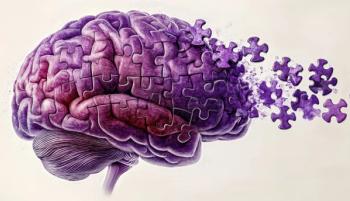
- Vol 31 No 6
- Volume 31
- Issue 6
Science or Sales? The Evidence and Application of Brain Training Games
A discussion of computerized cognitive training programs with the most independent supportive research that demonstrates a previously unrecognized degree of neuroplasticity, or cognitive flexibility, in the brain.
Over the past 5 years, computerized cognitive training (CT) programs have made a huge splash in the digital wellness market. These programs, usually consisting of small computer games, have capitalized on recent research that shows a previously unrecognized degree of neuroplasticity, or cognitive flexibility, in the brain.
Currently, research is moderately supportive of CT. In a 2010
[[{"type":"media","view_mode":"media_crop","fid":"25003","attributes":{"alt":"brain games","class":"media-image media-image-right","id":"media_crop_6839187894474","media_crop_h":"0","media_crop_image_style":"-1","media_crop_instance":"2222","media_crop_rotate":"0","media_crop_scale_h":"0","media_crop_scale_w":"0","media_crop_w":"0","media_crop_x":"0","media_crop_y":"0","style":"width: 199px; height: 149px; float: right;","title":" ","typeof":"foaf:Image"}}]]The research on specific programs, however, is uneven. Moreover, there is an obvious profit motive for companies to make claims about their software that exceed the demonstrated benefits. Here I will explore the research to determine which computer software systems have the most empirical support. The empirical findings will be supplemented by my own clinical experiences using these programs with patients with cognitive deficits.
A look at supportive research
The Figure describes the supportive studies of 6 different brain training companies (some companies, such as Fit Brains and Nintendo Brain Age, do not claim empirically supported cognitive benefits and have been excluded). The first category, in red, shows the total number of studies; this could include studies funded and conducted by the company itself, or a conference poster that was not peer-reviewed. The second category, in blue, indicates how many of those studies were empirical and peer-reviewed and were published in a journal.
The last category shows only those that were both peer-reviewed and conducted completely free of financial conflicts of interest. These studies promise the most objective and rigorous empirical evidence. I will discuss the 3 companies with the most independent supportive research-Cogmed, Posit Science, and Attention Process Training-as well as Lumosity, because of its relative dominance in the market.
Cogmed
With more independent, peer-reviewed research support than any other product, Cogmed claims to improve focus, attention, planning abilities, and task completion. Its training program primarily uses spatial and auditory working-memory span tasks, which work to increase the amount of information you can hold in your head and manipulate.
Span tasks might include a player listening to a list of numbers and then reentering them backwards, or a visual task similar to the popular children’s game Simon Says. Treatment programs typically last 5 weeks. Cogmed is owned by Pearson, the largest education company in the world, which charges fees for clinicians to become licensed program facilitators.
While independent studies evaluating Cogmed generally indicate that subjects improve at brain games, it is unclear whether these improvements translate into real-world functionality. Critics have cited small test sample sizes and non-replicated results as evidence that Cogmed’s claims are unsupported by research.2,3 Studies have also failed to show long-term, permanent gains, although with time this could change.
Perhaps most important, improving span is only one piece of working memory. The idea that improving span alone is sufficient to improve overall cognition in the face of other deficits in learning, memory, or executive function merits skepticism. Proponents of Cogmed research state that brain training shows promise, and that critics’ expectations are unrealistically high in these early stages of research.
Posit Science
With its bold motto, “Think Faster, Focus Better, Remember More,” Posit Science claims to enhance attention, mental processing speed, learning, memory, and even a sour mood.
In the past, Posit Science offered 2 products: an auditory package called “Brain Fitness,” and a visuospatial package called “InSight.” Both operated on the theory that enhancing perception speed and accuracy at the smallest units of auditory and visual processing will improve the entirety of these processing systems.
Recently, Posit Science created a new Internet-based platform (“Brain HQ”) that incorporates the games from both the auditory and visuospatial packages. This new platform allows the clinician to remotely monitor the frequency of use and provides limited information in terms of percentage improvements into a patient’s progress. However, “Brain HQ” lacks the degree of granularity available in the APT-3 package discussed below.
Clinically, the auditory games have strengths and weaknesses. Although the program begins with an assessment of auditory processing to establish difficulty levels, higher-functioning patients frequently find some of the games too easy and boring. This is not necessarily evidence that it does not work, but a lack of patient engagement has occasionally impeded progress in patients I have seen in clinical practice.
One of Posit Science’s visuospatial games, “Road Tour,” has more supportive evidence than any other single game by any manufacturer. Research funded by Posit Science has found that it slows cognitive decline in healthy, aging adults, and this was supported by an NIH-funded study indicating that it significantly improves mental processing speed.4 Very few interventions have been shown to increase processing speed, which makes these findings particularly unique. Processing speed is also one of the most common and devastating deficits among individuals with traumatic brain injury, so we can look forward to further studies involving this condition.
Attention Process Training-3 (APT-3)
Used by cognitive rehabilitation specialists for more than a decade to treat acquired brain injury and stroke, APT-3 only recently computerized its regimen of treatment programs. It features a diverse array of exercises that target aspects of attention, such as sustaining attention, ignoring distractions, and maintaining multiple pieces of information simultaneously.
APT-3 is distinctive in that it was not originally designed for healthy people experiencing natural cognitive decline, but for treating acquired cognitive deficits. The design of the APT-3 program allows a clinician to pace the tasks and elevate their difficulty according to patient progress. Research has shown it to significantly improve attention in
Lumosity
Despite its weak research base, Lumosity is currently the biggest player in the field, with over 45 million users and more than 1 billion games played. It claims to be a comprehensive solution for virtually all cognitive domains-memory, processing speed, problem solving, attention, and flexibility.
Despite its strong marketing brand, however, few independent studies have examined its claims. Its benefits have been demonstrated in independent research among very specific demographics, including post-chemotherapy cancer patients and young girls with Turner syndrome, but it is hard to say whether these results are generalizable to the population as a whole. Although Lumosity currently lacks substantial empirical support, it will likely produce interesting research in the coming years, given that its sample sizes can exceed 100,000 participants-a rarity in most research institutions.
Conclusion
These programs are relatively early in their development, but forthcoming research will surely optimize and refine them. In addition to the programs reviewed here, a number of other brain training programs are in relatively early phases of development. Some show a promising evidence base and have been designed by academic scientists, including “ACTIVATE” by Yale researcher Dr Bruce Wexler and “NeuroRacer” by researchers at the University of California, San Francisco. “NeuroRacer” was shown to improve cognitive control in older adults even in non-game tasks; although not available for purchase now, a commercial version by Akili Interactive Labs is in the works.6
In the future, we can expect virtual reality software that mimics a work or home environment and that allows brain-injured individuals to practice office and domestic skills. Such programs will almost certainly end the debate over whether these programs actually improve real-world functioning.
Nonetheless, some programs currently have enough empirical support for use in both rehabilitation and healthy, aging populations. Their affordability, accessibility, and ease of use make them particularly attractive, and computerization allows programs to track progress and adapt to the user’s strengths and weaknesses.
For cognitive rehabilitation, they can be a useful supplement to traditional treatment by allowing patients to continue rehabilitation from the comfort of their own home. In my own practice, I use both the Posit Science and APT programs for the reasons listed above. Overall, computerized brain training games provide an exciting opportunity for aging adults and patients with acquired brain injury to improve cognitive functioning.
Computerized CT programs discussed in this article
Cogmed:
Posit Science:
Attention Process Training-3 (APT-3):
Lumosity:
ACTIVATE:
NeuroRacer:
This article was originally posted online on 04/29/2014.
Disclosures:
Dr Brooks is a Voluntary Assistant Professor of Research in the department of physical medicine and rehabilitation at the Miller School of Medicine, University of Miami. He is a clinical neuropsychologist in private practice in Miami and Hollywood, Fla. He specializes in the assessment and cognitive rehabilitation of individuals with neurological disorders. He currently participates in research on the development of brain training software but has no financial interest in any brain training products. Dr Brooks’ Web site is:
References:
1. Plassman BL, Williams JW Jr, Burke JR, et al. Systematic review: factors associated with risk for and possible prevention of cognitive decline in later life. Ann Intern Med. 2010;153:182-193.
2. Shipstead Z, Hicks KL, Engle RW. Cogmed working memory training: does the evidence support the claims? J Appl Res Mem Cogn. 2012;1:185-193.
3. Hulme C, Melby-Lervåg M. Current evidence does not support the claims made for CogMed working memory training. J Appl Res Mem Cogn. 2012;1:197-200.
4. Wolinksy FD, Vander Weg MW, Howren MB, et al. A randomized controlled trial of cognitive training using a visual speed of processing intervention in middle aged and older adults. PLoS One. 2013;8:e61624.
5. Barker-Collo SL, Feigin VL, Lawes CM, et al. Reducing attention deficits after stroke using attention process training: a randomized controlled trial. Stroke. 2009;40:3293-3298.
6. Anguera JA, Boccanfuso J, Rintoul JL, et al. Video game training enhances cognitive control in older adults. Nature. 2013;501:97-101.
Articles in this issue
over 11 years ago
Brave New Directions in Alcohol Use Disorders: An Overviewover 11 years ago
Intimate Portrait: Richard M. Berlin, MDover 11 years ago
Telepsychiatry Is a Team Sportover 11 years ago
Igor, My Two-Year-Old Grandson, Takes Me for a Weekend at the Beachover 11 years ago
Igor Is Now Grown UpNewsletter
Receive trusted psychiatric news, expert analysis, and clinical insights — subscribe today to support your practice and your patients.

















